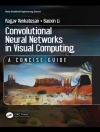The Only Resource to Cover Wireless, Wireline, and Optical
Networks in One Volume
Mobile and stationary next-generation networks that access the
photonic core are destined to become as ubiquitous as traditional
telephone networks. These networks must efficiently provide
adequate network quality to multimedia applications with high
bandwidth and strict quality-of-service requirements, as well as
seamlessly integrate mobile and fixed architectures. Today’s
engineering students must be properly prepared to meet the
challenges of next-generation network development and
deployment.
Featuring contributions from top industrial experts and academic
professors, this authoritative work provides a comprehensive
introduction to next-generation networks. It explains wireless
networks such as wireless local area networks (WLAN), wireless
personal area networks (WPAN), wireless access, 3G/4G cellular, and
RF transmission, as well as optical networks like long-haul and
metropolitan networks, optical fiber, photonic devices, and VLSI
chips. Rather than focusing on heavy math or physical details, this
resource explores how the technology is being used. It describes
access and transport network layer technologies while also
discussing the network and services aspects.
Chapter coverage includes:
* Fiber-wireless networks: technologies, architectures, and
future challenges
* Packet backhaul network
* Point-to-point microwave backhaul
* Fourth-generation broadband: paving the road to Gbit/s with
copper
* Dynamic bandwidth allocation in EPON and GPON
* Next-generation ethernet passive optical networks: 10G-EPON
* Power line communications and smart grids
* Signaling for multimedia conferencing in 4G: architecture,
evaluation, and issues
* Self-coexistence and security in cognitive radio networks
* Mobile Wi MAX
* UWB personal area networks–MIMO extensions
* Next-generation integrated metropolitan-access network:
technology integration and wireless convergence
* Resilient burst ring: a novel technology for the next-generation
metropolitan area networks
Filled with illustrations and practical examples from industry,
this book will be invaluable to engineers and researchers in
industry and academia, as well as senior undergraduate and graduate
students, marketing and management staff, photonics physicists, and
chip designers.
Tabella dei contenuti
Preface.
Contributors.
Part I Access and Backhaul Networks.
1 Roadmap for Next Generation Communications Networks
(María Ángeles Callejo Rodríguez and José
Enríquez Gabeiras).
2 Wide-Area Ubiquitous Network: An Infrastructure for Sensor and
Actuator Networking (Hiroshi Saito, Masato Matsuo, Osamu Kagami,
Shigeru Kuwano, Daisei Uchida, and Yuichi Kado).
3 Wireline Access Networks (Scott Reynolds).
4 Fiber-Wireless (FIWI) Networks: Technologies, Architectures,
and Future Challenges (Navid Ghazisaidi and Martin
Maier).
5 Packet Backhaul Network (Hao Long).
6 Microwave Backhaul Networks (Ron Nadiv).
Part II Wireline Technologies.
7 Paving the Road to Gbit/s Broadband Access with Copper
(Thomas Magesacher, Per Ödling, Miguel Berg, Stefan
Höst, Enrique Areizaga, Per Ola Börjesson and Eduardo
Jacob).
8 Dynamic Bandwidth Allocation in EPON and GPON (Björn
Skubic, Jiajia Chen, Jawwad Ahmed, Biao Chen and Lena
Wosinska).
9 Next-Generation Ethernet Passive Optical Networks: 10G-EPON
(Marek Hajduczenia and Henrique J. A. da Silva).
10 Broadband Powerline Communications (Lars Torsten
Berger).
11 Power Line Communications and Smart Grids (Tae Eung Sung
and Adam Bojanczyk).
Part III Wireless Technologies and Spectrum
Management.
12 Signaling for Multimedia Conferencing in 4G: Architecture,
Evaluation and Issues (Chunyan Fu, Ferhat Khendek and Roch
Glitho).
13 Self-Coexistence and Security in Cognitive Radio Networks
(Shamik Sengupta, Santhanakrishnan Anand, and Rajarathnam
Chandramouli).
14 Mobile WIMAX (Aryan Saèd).
15 Ulta-Wideband Personal Area Networks: MIMO Extensions
(Cheran Vithanage, Magnus Sandell, Justin P. Coon and Yue
Wang).
Part IV Metropolitan, Core, and Storage Area
Networks.
16 Next-Generation Integrated Metropolitan-Access Network:
Technology Integration and Wireless Convergence (Shing-Wa Wong,
Divanilson R. Campelo, and Leonid G. Kazovsky).
17 Resilient Burst Ring: A Novel Technology for Next-Generation
Metropolitan Area Networks (Yuefeng Ji and Xin Liu).
18 Multiprotocol Label Switching (Mario Baldi).
19 Overview of Storage Networking and Storage Networks
(Eugene Ortenberg and Christian van den Branden).
Part V Photonic and Electronic Component Technology.
20 ROADM architectures and WSS Implementation Technologies
(Neo Antoniades, George Ellinas, Jonathan Homa and Krishna
Bala).
21 Integrated Circuits for Dispersion Compensation in Optical
Communication Links (Anthony Chan Carusone, Faisal A. Musa,
Jonathan Sewter, and George Ng).
22 High-End Silicon Photodiode Integrated Circuits (Bernhard
Goll, Robert Swoboda and Horst Zimmermann).
23 MIMO Wireless Transceiver Design Incorporating Hybrid ARQ
(Dimitris Toumpakaris, Jungwon Lee, Edward W. Jang, Hui-Ling
Lou, and John M. Cioffi).
24 Radio-Frequency Transmitters (Alireza Zolfaghari, Hooman
Darabi and Henrik Jensen).
Index.
Circa l’autore
KRZYSZTOF INIEWSKI, PHD, is the Executive Director at CMOS Emerging Technologies. His research interests are in VLSI circuits for medical and security applications. From 2005 to 2006, he was an associate professor in the Electrical Engineering and Computer Engineering Department of the University of Alberta, where he conducted research on low-power wireless circuits and systems. Dr. Iniewski has published over 100 research papers in international journals and conferences. He holds eighteen international patents granted in the United States, Canada, France, Germany, and Japan.












